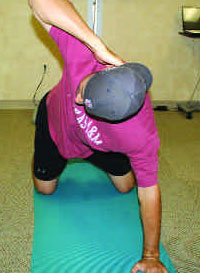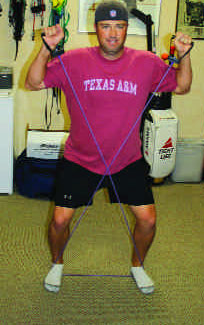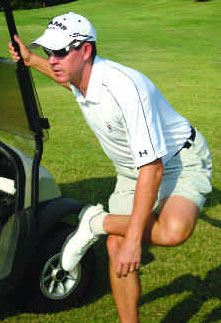
 A majority of golfers struggle with back pain. Coincidentally, a majority of amateurs struggle with a slice.
A majority of golfers struggle with back pain. Coincidentally, a majority of amateurs struggle with a slice.
Last year, there were 25 million doctor visits for golf-related injuries. Not surprisingly, back pain was the most common reason. The position in which the golfer puts his spine when hitting a slice is a major technique fault that can create back pain.
When assessing an injured golfer, I focus on three parameters in this order:
- Physical dysfunction
- Technique
- Equipment
There are many causes of back pain, but I won’t bore you with most. However, I will address one of the most common causes, which falls into the technique category. It’s called “the sway.”
Sway is any lateral movement of the lower body away from the target during the backswing. This forces the weight to the outside of back foot, resulting in improper weight shift during transition.
In order to turn into your right hip (for righthanded golfers), there are several physical parameters that must be developed. The most important is right hip internal rotation. If the body is not able to turn around the right hip due to joint or muscle restrictions, then lateral movement will occur.
Secondly, the ability to separate your upper body from your lower body allows you to make a shoulder turn without swaying. Limited spinal mobility is the main cause of this restriction.
 Finally, the ability to laterally stabilize your right leg during the backswing is directly proportional to the strength and stability of your glute muscles. This muscle helps prevent the right hip from elevating and shifting laterally during the backswing.
Finally, the ability to laterally stabilize your right leg during the backswing is directly proportional to the strength and stability of your glute muscles. This muscle helps prevent the right hip from elevating and shifting laterally during the backswing.
A majority of golfers struggle with the sway, but most don’t know the sway is the beginning phase of the dreaded slice. In trying to correct the slice, most will try to influence the grip and address posture, which are both important. What often is forgotten is fixing the sway.
You’re probably asking by now, how does the sway create the slice and be a causative factor in causing back pain?
If you sway, there is no stable foundation to drive your weight off the right foot during transition into downswing. The golfer loses power and suffers a breakdown of the kinetic sequence. As the golfer sways, his head and upper body will tilt toward the target, creating a reverse spine angle. This will put a tremendous amount of undue stress on the left side of the spine.
The golfer will initiate the downswing with his arms creating an over-the-top move, causing an outside- to-inside swing path. This will put a clockwise spin on the ball, and a slice will occur. At follow through, another reverse spine angle occurs creating a “crunch factor” causing right low back pain.
As is evident, there is a direct correlation between the slice and back pain. So, the question is: how do I correct the slice and prevent back pain?
Most commonly it is a technique fault caused by body-swing disconnection, which are limitations and weaknesses in the body that have been described above. The top three target areas to address are:
Spinal Mobility (top photo): This exercise called “reach backs” and will help improve spinal flexibility. This will help the golfer initiate the downswing with the hips instead of arms/hands.
 Hip Stability (middle photo): These X-walks will improve hip stability, which prevents the hips from moving away from target during the backswing.
Hip Stability (middle photo): These X-walks will improve hip stability, which prevents the hips from moving away from target during the backswing.
Hip Mobility (bottom photo): This helps the golfer turn around the hip with the upper body.
I’m still shocked by the amount of time and money golfers spend on gimmicky training aids, clubs, balls, etc., to fix the slice. With all the new technology, the average score in America has not changed in 20 years.
I understand we live in a society where we all want a quick fix. But the old saying, “Rome wasn’t built in a day” holds true in golf.
As we have all witnessed, some of the best golfers in the world have worked to change their swing and have taken up to two years to see their results. We should not think any different. What is not seen is the dedicated training done behind the scenes, where the golfers work diligently on their bodies through treatment and training that will allow their bodies to get into positions that is needed for the swing change.
In summary, my recommendations are to seek out a medical golf professional that can assess you and provide a specific treatment/training program to prevent back pain and improve your body, so you and your golf instructor don’t become frustrated with a lack of progress.
Dr. Troy Van Biezen
Dr. Troy Van Biezen is one of the most recognized medical golf professionals in the country. He’s the PGA Tour Sports Medicine Team’s chiropractor and a Level 2 Titleist Performance Institute Medical Professional. He travels with the PGA Tour regularly, and regularly treats and trains local Tour pros such as Corey Pavin, Ryan Palmer, Colt Knost, Ben Crane, Matt Weibring, D.A. Weibring, Brian Watts, Paul Stankowski, Tommy Armour III and Harrison Frazar. He also works with well-respected golf instructors Randy Smith, Cameron Doan and Rod Cook. Dr. Van Biezen has been profiled in numerous articles including Golf World, Golfweek and pgatour.com. He resides in Dallas with his wife and two beautiful daughters.
